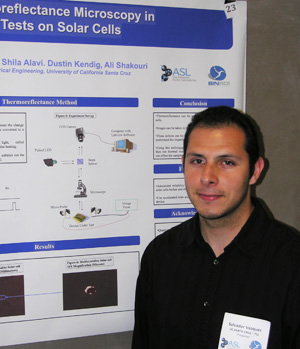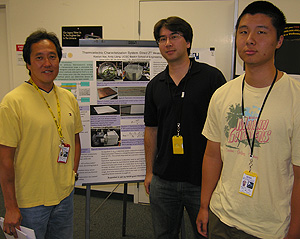Dozens of students gained valuable experience in nanotechnology and energy research labs this summer through an internship program at the Advanced Studies Laboratories (ASL), a collaborative partnership led by UC Santa Cruz and NASA Ames Research Center. The student research projects, ranging from solar energy technology to thermoelectric devices, were on display in a poster session held last week in the ASL facility at NASA Ames, located at Moffett Field in Mountain View.
Much of the funding for the internship program is provided by the Bio-Info-Nano Research and Development Institute (BIN-RDI), which is affiliated with ASL and was established through a NASA grant with support from Congressman Mike Honda (15th district). UCSC's Silicon Valley Initiatives also provided funding for summer interns.
"The internship program expanded by leaps and bounds this year," said BIN-RDI director Richard Hughey, a professor of computer engineering in the Baskin School of Engineering at UCSC. "We have about 15 students from UCSC and San Jose State University, there's another BIN-RDI program with a like number of students from Santa Clara University, and then there are various NASA programs that fund interns at ASL. It's a great opportunity for students to take part in nanotechnology research and training."
Salvador Vasquez, an undergraduate in electrical engineering at UCSC, said working in a research lab has been a great experience for him. "You learn how to work as part of a large research group, and you also get a sense of what graduate school is like," he said. "I'm thinking about going to graduate school, and I might not have considered that if I hadn't had this experience."
Vasquez has been working in the Thermal Characterization Laboratory led by Ali Shakouri, professor of electrical engineering at UCSC. His summer project involved using a technique called thermoreflectance imaging to look for defects in solar cells that can affect their efficiency and reliability.
In addition to Shakouri, other UCSC faculty with research labs at the ASL facility include Glenn Alers, adjunct professor of physics; Sue Carter, professor of physics; Bin Chen, adjunct professor of electrical engineering; Joel Kubby, associate professor of electrical engineering; and Nobuhiko Kobayashi, associate professor of electrical engineering and co-director of ASL. Several faculty from Santa Clara University, an ASL affiliate, also have labs at the facility.
Nathan Green, who graduated from UCSC in June with a B.S. in applied physics, studied solar concentrators in the Solar Energy and Renewable Fuels (SERF) lab led by Alers and Carter. Luminescent films can be used to concentrate sunlight onto solar cells and increase efficiency. But exposure to water and oxygen in the atmosphere can degrade the films, so Green studied the effectiveness of sealing luminescent films in an oxygen- and water-free environment to prevent degradation.
"With a solar concentrator, you don't need as many photovoltaic cells, so it can potentially reduce the cost of solar energy systems," he said.
Kobayashi had five students working in his Nanostructured Energy Conversion Technology & Research (NECTAR) lab this summer. The NECTAR lab investigates nanoscale materials and technologies for the development of efficient, reliable, and cost-effective devices that convert light and heat energy sources into useful electrical power. Undergraduate Andy Liang worked with Kobayashi and graduate student Kaelan Yee on a project to measure the efficiency of thermoelectric devices, which convert heat into electricity.
"People don't expect to find materials science research at UCSC, but it is an important area of research for us now," Kobayashi said. "The internship program is a great opportunity for me to interact with students and get them involved in this research."
The eight-week internship program included seminars presented by ASL, NASA, and Santa Clara University researchers; a two-day workshop on Ethics in Science and another workshop on Technical Writing and Communications; a tour of the NASA Ames campus; and weekly seminars presented by the interns.
Santa Clara University chemistry professor and senior associate dean Amy Shachter worked with Hughey to design the SCU internship program at ASL. SCU undergraduate Sarah Ghanbari won an award for the project "of greatest benefit to society" for her poster describing a microfluidic system for rapidly detecting disease-causing organisms in water samples. Ghanbari worked with SCU bioengineer Unyoung (Ashley) Kim on the project, which aims to develop inexpensive, portable devices for use in the developing world.
Currently, a major focus of ASL and BIN-RDI is the establishment of a shared facility to provide state-of-the-art equipment for nanotechnology and materials science research. The Materials Analysis for Collaborative Science (MACS) facility recently acquired a new scanning electron microscope with x-ray analysis technology that enables rapid chemical analysis of samples. Other major instruments will be installed this fall, including a new transmission electron microscope and an x-ray photoelectron spectroscopy (XPS) instrument.




